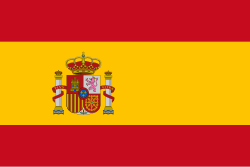This article needs additional citations for verification .(November 2025) |

In heraldry and vexillology, a Spanish fess is a term occasionally used to describe the central horizontal stripe of a tricolour or triband flag that is twice the width of the stripes on either side of it. [1]
Contents
The name is based on the most well-known example of this style of flag, the flag of Spain, [2] and in analogy to the equivalent term for vertically striped flags, the Canadian pale.



























